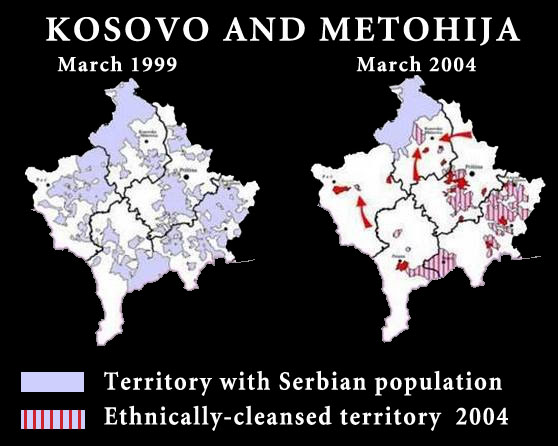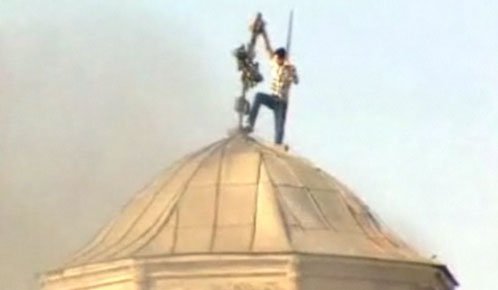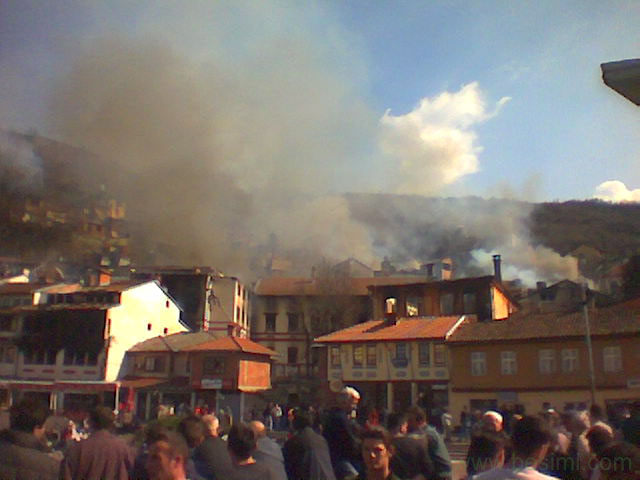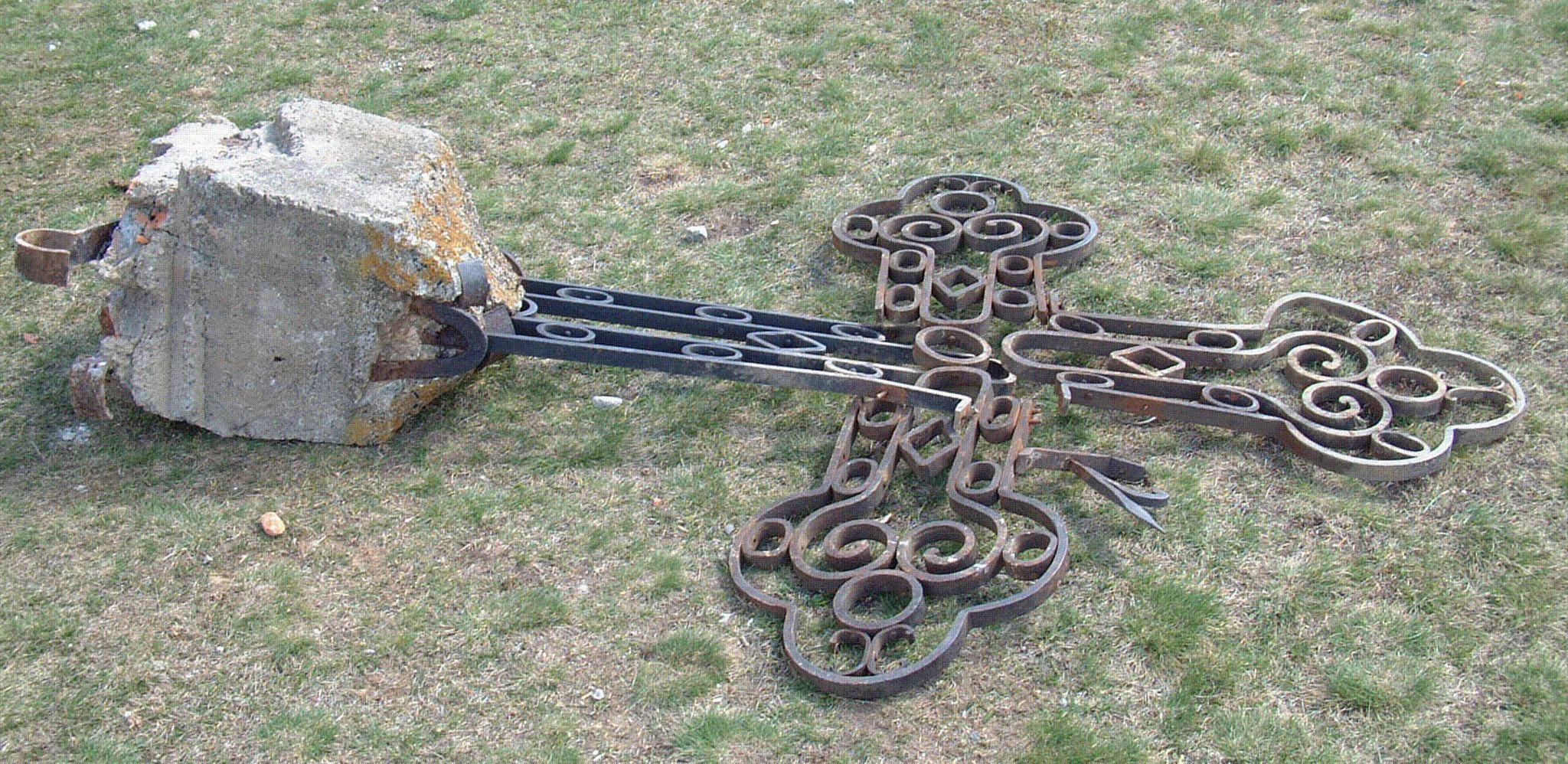Period:
21st century
Region:
Kosovo and Metohia
The Albanian crime March Pogrom - Kosovo 2004
The March Pogrom refers to the series of massive attacks conducted by Albanian terrorists and initiated by Albanian leaders of the so-called “Republic of Kosovo” against the remaining Serbian civilians, who lived in Kosovo and Metohija in 2004. These attacks were the consequence of increasing tensions between Serbs and Albanians after an incidental drowning of two Albanian boys in the river Ibar near the town Zubin Potok. Albanian media and politicians accused Serbs of the death of these boys.
Albanian extremists expelled a large number of Serbs on 17 March 2004, burned their houses and destroyed cultural and historical monuments. A two-day attack by Albanian extremists against Serbian civilians has led to the most massive expulsion of Serbs from 1999.
It was estimated that 4,000 Serbs were expelled from their homes throughout Kosovo and Metohija. During expulsion, 28 people were killed, 35 monasteries were destroyed and 930 houses were burnt and destroyed. Although the international representatives expressed condemnation, a lot of perpetrators have remained unpunished yet.
BACKGROUND
On On 15 January 1999, in the Kosovo village of Račak, Serbian police clashed with Albanian terrorists. The Western Media falsely reported that Serbian policemen killed Albanian civilians. They were instructed by William Walker, the head of the Kosovo Verification Mission.

Holbrooke in Belgrade with false offer
This case served as justification for the aggression and bombing of Serbia and Montenegro in 1999, which the Government of Serbia attempted to avoid in negotiations with Kosovo Albanians in Rambouillet. As this attempt failed, American general Wesley Clark ordered the bombing, which turned into genocidal action known as “Merciful Angel.”
THE REASON FOR THE ATTACK
The official reason for violence by Albanian extremists was the drowning of two Albanian boys in the village Čabra near the town Zubin Potok. According to their interpretation of the incident, while the boys were running from the Serbian village Zupce, they fell into the river Ibar and drowned. However, there is no evidence for this interpretation.

By later investigation led by UNMIK, it was proved that these accusations were false. The UNMIK representative Nerige Sing said that children had been under pressure from Albanian politicians and media to accuse Serbs from the neighboring village. Another UNMIK representative, Dereck Chapel denied that the boys died while escaping from Serbs and stated that the violence was planned.
Furthermore, in light of the fact that the river Ibar was on a higher level that day due to the release of water from Gazivode dam, the accidental fall of the boys into the water would have left fatal consequences. This incident served as a trigger for Albanian extremists to initiate pogrom which was planned for a long period of time. This is proved by the fact that the violence has soon extended to the entire territory of Kosovo and Metohija.
THE POGROM IN EACH PLACE
This accurately conducted attack can be seen as organized violence which Albanians started with the aim of ethnic cleansing and intimidation.
In fact, violence was one part of the carefully organized plan. Certain data show that the ethnic structure was completely transformed in some places. Below is a review of events that happened during the pogrom in specific places.
Kosovska Mitrovica
The city is divided into Northern and Southern parts. The Southern part is populated only by the Albanian population and the Northern part is multiethnic where Serbs, Albanians, Roma, and Bosnian people live in three communities. The number of Serbs was around 16,000 until the arrival of KFOR in 1999 when 2,000 were relocated from the south part of the city. At the moment the pogrom happened, 14,000 Serbs lived in Kosovska Mitrovica.

The major confrontations happened in this place because there was the largest concentration of Serbs in Kosovo and Metohija. They were concentrated around the bridge of the river Ibar which divides two parts of the city and it is of strategic importance for the whole city. At 4 pm on 16 March 2004, after Albanian media reported that three Albanian boys had drowned in the village Čabra, members of the UNMIK police blocked the bridge which separates north and south of the city, with the aim of preventing potential conflicts.
On the next day, a larger number of Albanians gathered in the south part of the city. At 11 am, protesters led by 200 extremists, armed with weapons and bombs started to move towards the bridge. The part of protesters managed to break the blockade and enter the northern part of the city while the others went into conflict with the UNMIK police and a few members of KPS. At the same time, at 11:15, 150 Serbs went to the bridge to prevent the intrusion of Albanian protesters. This is when Albanians started to attack Serbs, KFOR, and UNMIK policemen with stones. Policemen used tear gas, shock bombs, and rubber bullets while the members of the special units of UNMIK police from Poland tried to block access to the bridge at 11:30.
First shots from firearms towards Serbs from the northern part were recorded at 12:00 from “Tri Solitera”. Albanian extremists began to throw Molotov cocktails towards the vehicles of the UNMIK police. At 13:00 Albanian extremists managed to enter the northern part of the city across the pedestrian bridge near “Tri Solitera”. The largest number of Serbs moved to this bridge to prevent Albanian extremists from reaching other parts and conducting massacres on a wide scale.
At the same time, Albanian terrorists from the buildings in “Tri Solitera” started to throw bombs and opened fire from automatic guns and snipers against the members of international forces and Serbian people. They were supported by extremists who began shooting Serbs from the park near the bridge. On this occasion, Borivoje Spasojević (born in 1941) and Jana Tucev (born in 1968) were killed, and Simeon Simeonov, a Bulgarian policeman was wounded. In the afternoon, the international forces managed to restore order in the northern part of the city, while in the southern part major groups of Albanians continued shooting against UNMIK and KFOR policemen. There were some shootings towards Serbian suburb Brdo.
The day later, Albanian extremists continued with demonstrations, and the group of 1,000 Albanians, who gathered near the former building of “Beobanka” began to move towards the bridge. Albanian extremists tried to burn the Church of Saint Sava in the southern part of the city and at 12:30 the sleeping quarters and additional premises were burnt in the garden of the church. The church was burnt at 18:00.
The sound of sporadic shooting could be still heard during the night, and the members of KFOR killed an Albanian sniper. On the morning of 19 March, Albanian terrorists shelled the northern part of the city from the quarter Tamnik in the southern part.
Svinjare
More than 300 Serbs lived in this multiethnic village, 3 km away from the road Kosovska Mitrovica-Priština, surrounded by Albanians. Before the NATO bombing, more than 900 Serbs lived there, and after the bombing, 200 people have left the place.
On 18 March 2004, Albanian extremists attacked the village between 12:00 and 13:00 and burned a large number of Serbian houses and facilities. Residents were moved with the assistance of UNMIK police from the attacking zone to another part of the village. At 17:00 women and children were evacuated from the village and later that day, KFOR evacuated the remaining residents.
At another part of the village, Albanian extremists began to burn Serbian houses and facilities. On 20 March, 120 residents of the village were safely relocated from the French military base to the town of Zvečan. After the pogrom, no one among Serbs has continued to live in the village.
Priština
Giving the fact that Pristina was ethnically cleansed before the pogrom, this only served to expel the remaining Serbs who continued to live there. Before the arrival of KFOR, there were 45,000 Serbs, but in Summer almost the entire population was expelled. 900 people remained in the city by the end of 1999 and only 225 by 2002.

On 17 March 2004, Albanian extremists overtook the police station of UNMIK in Vranjevac and burned several police cars. On the same day, the building “YU Program”, where a large number of Serbs lived was attacked. Albanian extremists burned the building and 30 residents of Serbian nationality found shelter in one apartment.
After a number of attempts, KFOR forces managed to evacuate Serbs to their base, and people of Serbian nationality, who worked in the UNMIK administration were moved to Central Serbia. The Church of Saint Nicola was burned, only to be renewed in 2009. After the pogrom, all people of Serbian nationality have left Priština, although 50 of them returned later.
Čaglavica
Čaglavica is a Serbian village, 2.5 km away from Priština with 1,500 residents. Before 1999, around 2,200 Serbs lived there and most of them continued so because its population was almost entirely Serbian.

On 15 March 2004, Albanian terrorists wounded a boy Jovica Ivić, who was taken to the hospital in Kosovska Mitrovica. This triggered protests of people in Čaglavica and nearby Serbian villages (Gračanica, Sušica, Lapnje Selo, Preoca, etc.), and they blocked main roads to Skoplje and Gnjilane. The incidents with local Albanians also occurred. In the afternoon of 17 March, several thousand Albanians from Priština came to the village Čaglavica.
At the entrance to the village, they faced the police cordon of KFOR, which they managed to break and get into the northern part of the village where they burned a dozen of Serbian houses and several cars with Molotov cocktails. During persistent attacks of Albanians, several Serbs were wounded by snipers or bombs. Several police cars were burned and more than 10 members of KFOR were wounded. On the same day, members of KFOR and UNMIK evacuated children, women, and elders from Čaglavica to Lapnje Selo and Gracanica. At 18:00 American soldiers came to the Čaglavica from Uroševac with 30 armed vehicles.
Only after their intervention, Albanians retreated to Priština. On 18 March, at the Veternik hill near Čaglavica, a large group of Albanians gathered trying to get into Čaglavica but they were prevented by members of KFOR, who came from the military base Bondstil.
Gračanica
Gračanica is a place in Kosovo and Metohija named by the monastery that was built in the 14th century. After the conflicts in 1999, only Serbs lived there. The number of people living in this town remained almost unchanged after the bombing with 45,000 residents.

After international forces prevented Serbs from Gračanica to join protests of Serbs in Čaglavica, people blocked the road Priština-Gnjilane. In the afternoon of 17 March 1,000 Albanians left Priština and went towards Čaglavica, Laplje Selo, and Gračanica to occupy these villages. Serbs from Gračanica put barriers on the way to Priština. A barricade was placed in the nearby village of Kišnica from Gnjilane, where the incidents with Albanian extremists also occurred.
After the evacuation of children and women from Čaglavica to Laplje Selo, and Gračanica, the members of KFOR advised Serbs from Gračanica to arm themselves and defend their place, because KFOR units weren’t capable of protecting their lives from Albanian extremists. According to the report of the Red Cross from 19 March, by 14:30 around 200 refugees from Lipljan, Kosovo Polje and Kišnica came to Gračanica.
Some people found shelter at their cousins’ houses, while the Red Cross accepted 120 people. On 23 March, members of KFOR relocated 200 Serbs from the military base in Priština and Obilić to Gračanica.
Laplje Selo
According to the OEBS, more than 1,500 Serbs and 150 Roma people lived in Laplje Selo in the vicinity of Priština. Before the attack of Čaglavica that Albanian terrorists started on 17 March 2004, members of KFOR and UNMIK evacuated Serbian women, children, and elders to the nearby Laplje Selo and Gračanica. At the entrance to the village, the conflict between Albanian extremists and the international forces occurred on the night of 17-18 March.
Obilić
According to OEBS, after the conflicts in 1999, around 3,600 Serbs lived in the town of Obilić, who also lived in the nearby villages of Miloševo, Babin Most, Plemetina, Crkvena Vodica, and Janina Voda. By the end of 1999, only 1,500 Serbs continued to live in this town, mostly in surrounding villages.

At 11:00 on 17 March, Albanian extremists started an attack on Serbs in Obilić. At the same time, sharp conflicts occurred between Albanian extremists and the international forces. Members of the Danish KFOR contingent and the UNMIK police tried to hold off the attack of Albanians until the evacuation of Serbs from Obilić was completed. More than 50 Serbs were surrounded by Albanians in Cerska street and in the building “YU Program”.
Albanian terrorists simultaneously entered several parts of the town in groups and began to burn houses,where Serbs were still living. They were beating everyone who tried to escape. Members of the Kosovo police (KPS) didn’t try to prevent violence against Serbian people and property.
During the evening of 18 March, Albanian terrorists burned abandoned Serbian houses in Obilić, and threw a bomb on the police station. The Serbian Church was also burned at the center of the town and the first aid station as well. On the same day, by 14:00 all Serbs from Obilić were expelled. They were placed in Lešak, the town of Leposavić, and in the KFOR camps near Kosovo Polje and Priština.
Kosovo polje
Until March 1999, around 9,000 Serbs and other non-Albanian citizens lived in this place. By the end of 1999, around 2,000 people still lived there, but after continuing migration and the 2004 pogrom, only a hundred left. They live in the building of the “YU Program '' with the protection of Norwegian members of KFOR.
On 17 March 2004, the remaining Serbs and other non-Albanians were expelled from Kosovo Polje. Albanians, who came from Drenica by buses and cars, burned the Town Hall, organized the attacks on the hospital, the school “St. Sava”, and 20 Serbian houses. Houses and all additional facilities were completely burnt. The two Orthodox churches in Kosovo Polje were burnt- the Church of St. Nicola from the 19th century and the Church of St. Katarina in the village of Bresje. A large number of graves were destroyed on the Orthodox graveyard which continued even after the pogrom.
Albanian terrorists killed Zlatibor Trajković (60) in front of the school and wounded Trifun Stiolović. A number of other Serbs were also taken to the hospital with more or less serious wounds.
Prizren
The ethnic cleansing of Prizren was conducted in the middle of 1999 so a small number of Serbs went through the torture during 2004 pogrom. Until the arrival of KFOR, around 12,000 Serbs lived in Prizren and almost the entire population were expelled before the pogrom in which only 60 remaining people suffered. It was Serbian cultural heritage that faced destruction, the one that was preserved in monasteries and churches.

The violence in this city began on March 17 at 15:00 when a large group of Albanians came from surrounding places. After displaying different slogans, they started violence by burning several UNMIK cars and later churches.
On this day, the following temples were destroyed in the area of Prizren- the Church of the Holy Virgin of Lyevish from the 12th century, the Church of the Holy Salvation from the 14th century, the Church of St. George from the 19th century, the Church of St. Nicola from the 14th century, the Church of St. George Runović from the 15th century, the Church of St. Nedelja from the 14th century, the Church of St. Panteleimon from the same period and the Church of Sts. Cosmas and Damian from the 14th century.
The Monastery of Sts. Archangels was burnt and seven monks were evacuated. Albanian terrorists burned the Seminary “Cyril and Methodius” and the premises of the eparchy which were the headquarters of the Archbishop of the diocese of Raška-Prizren. In the basement of the Seminary, the burnt body of Dragan Nedeljković from Prizren was found.
On March 18, 2004, near the German military base of KFOR in Prizren, the conflict occurred between Albanian extremists and the international forces. Albanians tried to enter the base, where 58 Serbs were evacuated but the attack was held off. Albanians destroyed several cars of UNMIK police, the official vehicles of the UN, and several private cars.
Peć
Like most of the other cities, Peć went through ethnic cleansing in June and July 1999, so the 2004 pogrom represents the final act of this process. Around 20,000 Serbs lived in Peć before KFOR arrived.
On 17 March 2004, during the attack all Serbian houses were burnt and Serbian people were evacuated to the Italian KFOR base in the village of Zagrmlje. In the afternoon, the conflict between Albanian terrorists and UNMIK police occurred when an Albanian man was killed. On 18 March, demonstrations were initiated due to the death of a former member of KLA, who was killed by UNMIK policemen on 17 March. Several thousands of people gathered for demonstrations.
During the three-day riots, the Church of St. John the Baptist was destroyed with the old metropolitanate, the parish house, and the Church of the Entry of the Most Holy Theotokos into the Temple in Belo Polje, which was destroyed in 1999 but was partially renewed for the liturgy. All gravestones were destroyed at the graveyard in Belo Polje.
Other places
The violence was spread to other places in Kosovo and Metohija as well. The actions were similar including intimidation of Serbian people and the burning of houses and orthodox churches. In the city of Uroševac, the graveyard was destroyed and the churches in surrounding villages: the Church of St Elijah in the village of Varoš, the Church of St. Peter and Paul in Talinovci, and the Church of the Holy Mother in the village of Sovtović. The Orthodox Cathedral was damaged with three hand-thrown grenades and at least 19 policemen of KFOR and UNMIK were wounded.

The Monastery Devich was destroyed in the vicinity of the place Srbica, which was ethnically cleansed in 1999. The members of KFOR previously evacuated all nuns after which at least 1,000 extremists destroyed and plundered the monastery. In the place of Podujevo, Albanians completely demolished the Orthodox graveyard. According to the testimonies of Czech soldiers of UNMIK, Albanian terrorists were taking chests from graves and destroying tombstones.
During the March pogrom in the town Štrpce in the village of Drajkovac, two Serbs were killed, Dobri Stolić (50), and his son Borko Stolić (22). They were killed in front of the house, where they were placed after they had left Uroševac in 1999. Other villages also suffered during the pogrom such as Gnjilane, Kosovska Kamenica, Štimlje, Vučitrn, and Orahovac.
AFTERMAHT
Around 4,000 Serbs were expelled from their houses although there is no accurate data. 28 people were killed, 35 orthodox churches were destroyed or damaged, and around 930 houses were burnt and destroyed.
Similar data can be found in the reports of UNMIK and the OEBS mission, which stated that the ethnic cleansing had lasted for three days resulting in 19 deaths, 954 wounded people, 4,100 displaced, 550 houses and 27 orthodox churches and monasteries burnt, and additional 182 houses burnt and two churches damaged.
Besides Serbs, Albanians attacked KFOR and UNMIK forces with a number of policemen and soldiers having been wounded. The Kosovo Police kept their distance except in the northern part of Kosovska Mitrovica where Serbs lived in the majority. The Republic of Serbia proclaimed the day of mourning in the memory of the victims.
REACTIONS
The International Community has condemned the crimes committed during these riots. The pogrom was seen as a continuation of the systematic ethnic cleansing of Kosovo and Metohija.

All NATO countries enhanced their military presence- Denmark with additional 100 soldiers, Germany with 600, France with 400, and Great Britain with 750. The UN Secretary Kofi Annan called Albanians to allow all ethnic minorities a normal life in the region. During the voting in Duma on 19 March, Russia called the International Community to allow the Army of Serbia and Montenegro to return to Kosovo and criticized UNMIK and KFOR that they were incapable to maintain peace and order in Kosovo and Metohija.
The representative of the UN administration in Kosovo, Harry Holkery stated that he condemned every form of violence but that the events that happened those days couldn’t be referred to as ethnic cleansing. This statement caused a strong response and condemnation by Serbian officials.
On the other side, commander of NATO for Southern Europe, Gregori Johnson, stated: “the wide-scaled violence throughout the whole Kosovo from the last two days was organized and arranged. To say that this was a multiethnic conflict is hypocrisy and a lie. What happens in Kosovo is a pogrom against a single nation and its history”.
During his visit to Kosovo Polje on 24 March 2004, Havier Solana, the representative of the European Union for Foreign Policy and Safety, stated:
- “I am terrified by the brutality, destroyed houses, preventing children from having an education, demolishing churches where people only want to pray. Serbs are brave and they must stay here, they must try to renew their houses and we are going to help them.”
Prime Minister of Serbia and Montenegro Vojislav Koštunica expressed strong condemnation and criticized the UN and NATO that they were incapable of ensuring safety to Serbs in Kosovo and Metohija. Minister for ethnic minorities Rasim Ljajić said: “What is happening in Kosovo and Metohija is the collapse of the International Law.”
President of the Coordination Center for Kosovo and Metohija, Nebojša Čović came to Kosovska Mitrovica on 18 March to regain tranquility among the remaining Serbs. Serbian forces enhanced control on administrative crossings with Kosovo to prevent actions of extremists from both sides. Thousands of citizens and the highest state officials led by the church dignitaries and the Patriarch of the Serbian Orthodox Church performed public prayers for the victims in the Church of St. Sava in Belgrade.
PUBLICATIONS
Several documentaries were made about the ethnic cleansing of the remaining Serbian population in occupied territory Kosovo and Metohija and the most well-known is The Crime Without Punishment.
INDICTMENTS AND TRIALS
A lot of perpetrators of this violence remained unpunished. No one among Albanian officials, who called people to demonstrations on the basis of false accusations of Serbs regarding their involvement in the drowning of the boys was tried. More than 50,000 Albanians are estimated to have participated in the pogrom, and only 4,000 were persecuted. By March 2010, only 143 people were arrested and 67 were kept in prison longer than a year. The Kosovo Police received more than 1,400 complaints regarding the crimes committed during the riots.
According to the OEBS report, most of the accusations were mild and the crimes were misclassified. For these mild accusations, the punishments were mitigated. The example is a case from Peć, where a defendant was charged for being involved in a group that prevented the police from performing its duties, although this group committed other criminal acts such as throwing stones towards the police and burning several Serbian houses.
Furthermore, witnesses that were mentioned in previous reports haven’t shown up on trials. Some witnesses, particularly of Albanian nationality changed their testimonies. In this way, all trials were brought into question.
No one was tried for murders and all punishments were minimal.
Tags:
Please, vote for this article:
Visited: 4294 point
Number of votes: 26
|